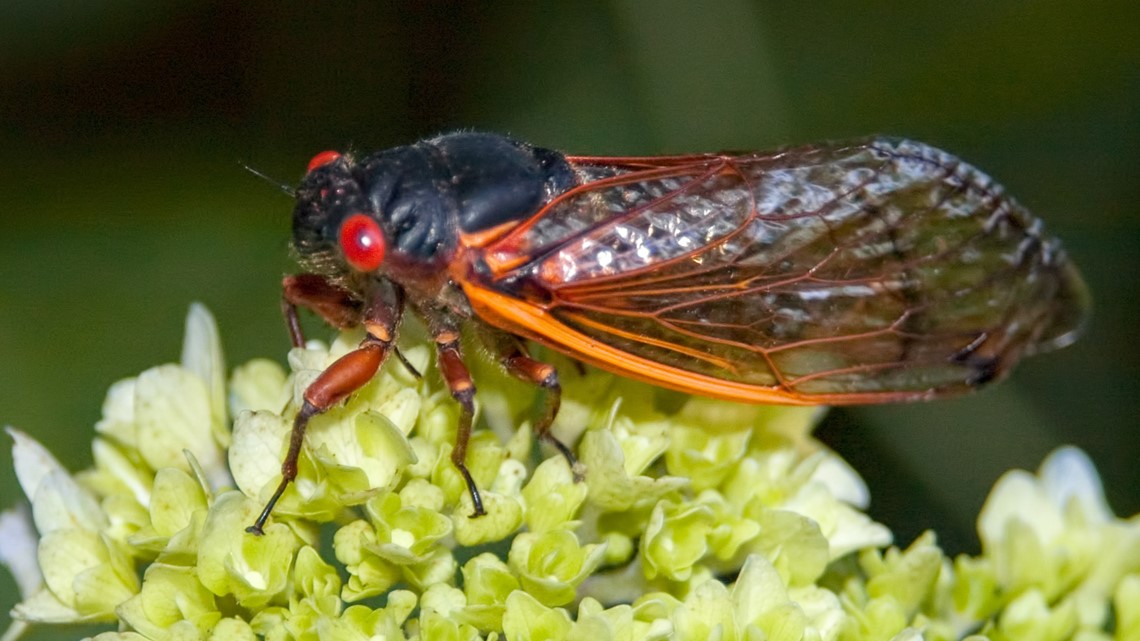INDIANAPOLIS — Bugged by all this snow? Brace yourselves. We’re in for storms of a different sort come summertime.
Think hoards of bloody-eyed cicadas that have muscled their way up to earth’s surface from underground lairs. These are beefed up bugs, trillions of them. Fueled up and strong from their nymph days spent sucking down plant root juices, whose translucent wings will greet the light of day for the first time in their lives.
Together, these cicadas will embark on a month-long campaign to eat and mate with anything in their path. One final frenzy before their inevitable deaths.
“It's about mating and getting those eggs laid,” said Dr. Luke Jacobus, an entomologist and Professor of Biology at Indiana University Purdue University in Columbus.
Such is the nature of periodical cicadas, any of the seven Magicicada species that are especially prominent throughout the southern and eastern United States. Other cicada species around the world can survive above ground for their nearly two-year long lifespan, but periodicals spend the majority of their lives feasting on liquid from tree roots in underground hideaways for more than a decade before resurfacing.
Some species are underground for 13 years, while others spend 17 years underground.
You may recall the infamous Brood X, themselves a 17-year brood of periodical cicadas who emerged over seven states in 2021.
Indiana University scientists estimate that brood produced 800,000 emergence holes per square acres in Monroe County alone.
“If you can assume that it's one cicada per hole, that would mean about 200 billion cicadas just in Monroe County. Now, you could say, wait a second, not the entire county is habitat. There are roads and parks, and all that stuff. So, let's cut that down to like 10%. You're still talking about 20 billion cicadas in one county,” said Dr. Armin Moczek, who is a professor of biology at Indiana University - Bloomington.
That cicada broods sprout up at the same time after many years spent underground is a phenomenon called mass emergence, a strategy scientists believe evolved as a way to ward off the many predators keen to enjoy a fresh, buggy buffet.


“It's really a way of overwhelming all the predators out there that might be trying to eat you. And so it's just winning by sheer numbers and so they come out these very large numbers,” said Dr. Jacobs.
But while broods emerge in 13 or 17-year increments on the dot, it’s very rare for two of those broods to pop up at the same time.
And that’s exactly what will happen this summer, when Brood XIII, a 17-year brood and Brood XIX, a 13-year brood, emerge from the earth.
For entomologists diligently tracking cicada emergence cycles, this magical, natural phenomenon is one that's on par with the upcoming solar eclipse.
“It is a wonder. It’s going to be something really cool that’s happening. Really rare. It just doesn’t happen - that you have two broods that are overlapping in their emergence, at the same time. So, it’s pretty lottery-level exciting,” said Dr. Elizabeth Long, who is an Assistant Professor & Extension Specialist with Purdue University’s Department of Entomology.
The last time two broods emerged simultaneously was 221 years ago, in 1803. Ralph Waldo Emergson was born that year, and the size of the United States had just doubled with the federal government’s finalizing the Louisiana Purchase from France.
So, go ahead and pencil in ‘rare cicada emergence’ on your list of high profile events slated for Indiana in 2024, alongside the arrival of Olympic swimmers and Taylor Swift. It's even fitting for the Swifites among us that one of the cicada broods shares the singer's affinity for the number 13.
“Thirteen and 17 are both prime numbers, which makes this kind of interesting and that reduces the chance that you're gonna have any overlap in time of the two different broods,” said Dr. Jacobs.
Brood XIX, also called the Great Southern Brood, is the largest periodical cicada group and will likely emerge in the middle of May throughout Indiana and a dozen other states, including Alabama, Arkansas, Georgia, Illinois, Indiana, Kentucky, Louisiana, Missouri, Mississippi, North Carolina, Oklahoma, South Carolina, Tennessee and Virginia.
Brood XII will sprout up in Indiana, Iowa, Wisconsin, Micighian and Illinois.
The simultaneous mass emergence could also mean cicadas who have not seen each other for 221 will meet their relatives, once again, hundreds of years later.
“That is really the crazy thing about these guys, apart from their extraordinary life cycle. Is that in Brood 19, for instance, there are three different species. And their closest relatives are not in the same brood their closest relatives are in the other brood, that is cycling at 17 years, in Brood 13,” Dr. Moczek said.
The cicadas only have about six weeks to mate and secure their bloodline for future generations.
Males will cluster in groups and sing a loud chorus to attract females to mate with, according to the National Wildlife Federation.
Females will lay their eggs atop branches. The trees where female cicadas have laid their eggs eventually become overwhelmed by the sheer amount of eggs, and abort the last foot or so of those branches.
When the branch falls, so do the tiny cicada eggs, scattering on the ground not far from the tree whose roots will provide their sustenance for more than a decade. The eggs will eventually hatch into tiny nymphs and bury themselves in the ground, not to be seen for 13 or 17 years.
“What we do not understand is the adaptive significance. If any, not everything has to have a value, sometimes things evolve for all sorts of reasons. But why cycle at 13 years or 17 years? We definitely do not understand that,” Mocek said.
But don’t think you’ll be fending off the roar of cicada broods this summer, or swiping them off your windshields.
Even though we’ll see two broods emerging at the same time, the cicadas will not be as obvious as they were as Brood X in 2021.
“Both broods are not as dense as Brood X was, and we are in the area of overlap between these two broods. For both of them, we're kind of at the edge of their geographic range. So, if you don't go look for them, there is a good chance you will miss them,” Dr. Moczek said.

